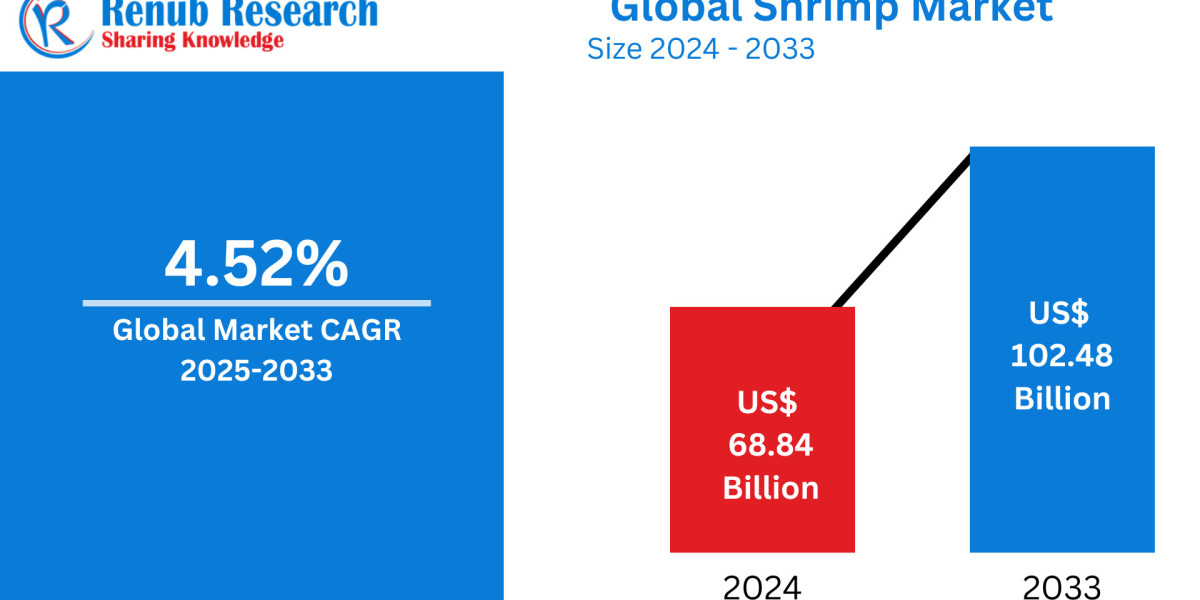Global Shrimp Market Size and Share Analysis: Growth Trends and Forecast Report 2025–2033
By Renub Research
Market Overview
The global shrimp market was valued at USD 68.84 billion in 2024 and is projected to reach USD 102.48 billion by 2033, expanding at a CAGR of 4.52% from 2025 to 2033. This growth is driven by the rising popularity of protein-rich diets, advancements in aquaculture technologies, and increasing demand for processed seafood.
Nutritional and Consumer Insights
Shrimp is a high-protein, low-fat seafood, rich in omega-3 fatty acids, iodine, vitamin B12, and antioxidants like astaxanthin. These attributes make shrimp popular among health-conscious consumers. It supports cardiovascular health, thyroid function, muscle growth, and anti-aging benefits. However, caution is needed for people with shellfish allergies or cholesterol sensitivities.
Market Growth Drivers
1. Rising Global Demand for Protein-Rich Seafood
Consumers are shifting toward pescatarian and fitness-oriented diets, replacing red meat with lean proteins like shrimp. Additionally, shrimp is a common ingredient across diverse global cuisines, boosting its demand.
Example: Skretting introduced "Elevia" feed in June 2023 to enhance shrimp hatchery nutrition and water quality.
2. Expansion of Shrimp Aquaculture
Countries like India, Vietnam, Ecuador, and Indonesia are heavily investing in shrimp farming using sustainable methods like Biofloc, Recirculating Aquaculture Systems (RAS), and disease-resistant strains.
Example: Thailand’s application of Ace Aquatec’s new humane stunning system (A-HSU) supported by the Shrimp Welfare Project.
3. Surge in Demand for Processed and Value-Added Products
Consumers in developed countries prefer frozen, cooked, and breaded shrimp for convenience. The foodservice and e-commerce grocery industries are playing a pivotal role in boosting accessibility.
Example: In February 2025, Labeyrie Fine Foods invested €18 million to double cooked shrimp capacity in France.
Market Challenges
1. Environmental and Sustainability Concerns
Shrimp aquaculture has been criticized for mangrove destruction, pollution, and antibiotic misuse. This has led to demands for certified, eco-friendly practices, such as those offered by ASC and MSC.
2. Supply Chain Disruptions & Trade Barriers
The shrimp industry is vulnerable to climate events, pandemics, and geopolitical trade tensions. Fluctuations in feed, fuel, and freight costs and stricter import regulations also pose risks.
New Publish Reports
· Thailand Shrimp Market Size and Share Analysis - Growth Trends and Forecast Report 2025-2033
· Taiwan Shrimp Market Size and Share Analysis - Growth Trends and Forecast Report 2025-2033
· Spain Shrimp Market Size and Share Analysis - Growth Trends and Forecast Report 2025-2033
· Singapore Shrimp Market Size and Share Analysis - Growth Trends and Forecast Report 2025-2033
Industry Landscape
Shrimp Farming Innovation
Leading producers (India, Ecuador, Vietnam, Indonesia) are embracing technological innovation to overcome disease outbreaks, production cost spikes, and environmental concerns.
Example: ICAR-CIBA introduced a super-intensive farming model in India addressing disease, cost, and climate change.
Policy Note: In Union Budget 2025, India raised the Kisan Credit Card limit to INR 5 lakh (USD 5,773) to support fishery growth.
Market Segmentation Analysis
By Species
- Whiteleg Shrimp (L. vannamei): Dominates due to high yield, low cost, and adaptability.
Example: Kazakhstan launched its first shrimp farm near Almaty in 2022.
- Black Tiger Shrimp (P. monodon): Larger size and premium flavor cater to luxury markets.
- Giant Freshwater Prawn (M. rosenbergii): Popular in Asia & Latin America for its tender meat.
By Size
- 15–20 Size Category: Valued in gourmet restaurants and specialty stores.
- 31–40 Size Category: Widely used in frozen and quick-serve formats due to its versatility.
By Product Form
- Breaded Shrimp: Gaining traction in fast-food and retail sectors.
- Cooked Shrimp: Ideal for consumers preferring ready-to-eat options.
- Green/Head-on Shrimp: Preferred in premium and gourmet markets, especially in Asia and Europe.
Regional Insights
United States
Strong demand from restaurants and supermarkets fuels imports from India, Ecuador, and Vietnam.
Example: CP Foods launched “Homegrown Shrimp USA” in Florida in April 2023.
Italy
With a rich seafood culture, Italy sees demand for both wild-caught and premium farmed shrimp.
Example: Lisaqua raised €4.9 million in 2022 to open France’s first land-based shrimp farm.
China
As the world’s top producer and consumer, China continues to dominate with a large domestic supply chain and robust consumption patterns.
10 Key Questions Answered in the Report
- What is the current size and future forecast of the global shrimp market?
USD 68.84 billion in 2024, expected to reach USD 102.48 billion by 2033.
- What is driving global shrimp consumption?
Health trends, convenience, and global culinary integration.
- Which shrimp species dominate the global market?
Whiteleg (L. vannamei) and Black Tiger (P. monodon).
- How are technological advancements shaping shrimp farming?
Use of Biofloc, RAS, disease-resistant species, and humane slaughter practices.
- What are the environmental impacts of shrimp farming?
Deforestation, water pollution, and overuse of antibiotics.
- Which regions are the largest producers of shrimp?
India, Vietnam, Ecuador, Indonesia.
- What are the major forms of processed shrimp in demand?
Breaded, cooked, peeled, and frozen shrimp.
- What is the significance of shrimp size categories in market segmentation?
Larger sizes preferred for gourmet use; medium sizes for mass market.
- How is government support aiding the shrimp industry?
Subsidies, credit limits, and policy support for sustainable aquaculture.
- What are the key challenges for exporters in the global shrimp market?
Supply chain issues, trade regulations, and rising input costs.
Conclusion
The global shrimp market is poised for robust growth as consumers seek healthy, convenient, and sustainable seafood. While challenges like environmental impact and regulatory pressures persist, technological innovation and expanding aquaculture provide a strong foundation for future expansion.
Renub Research anticipates continued market evolution, especially with rising interest in eco-friendly shrimp farming, processed products, and premium segments.








